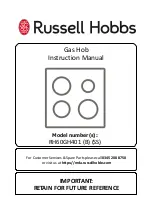
19
Electromagnetic hazards!
■
This appliance complies with
safety and electromagnetic
compatibility standards. However,
people with pacemakers or insulin
pumps must refrain from using
this appliance. It is impossible to
ensure that all of these devices
available on the market comply
with current electromagnetic
compatibility standards, and that
interference which may prevent
the device from working correctly
will not occur. It is also possible
that people with other types of
devices, such as a hearing aids,
could experience some
discomfort.
Hazard d ue to magn etism!
■
The removable control element is
magnetic and may affect
electronic implants, e. g. heart
pacemakers or insulin pumps. For
people with electronic implants:
never carry the control element in
clothing pockets. The minimum
distance to heart pacemaker
should be 10 cm.
Malfunction risk!
The hob is equipped with a fan in
the lower section. If there is a
drawer under the hob it should not
be used to store small objects or
paper, since they could damage
the fan or interfere with the cooling
if they are sucked into it.
There should be a minimum of
2 cm between the contents of the
drawer and fan intake.
Risk of injury!
■
When cooking in a bain marie, the
hob and cooking container could
shatter due to overheating. The
cooking container in the bain
marie must not directly touch the
bottom of the water-filled pot. Only
use heat-resistant cookware.
Risk of in jury!
■
Saucepans may suddenly jump
due to liquid between the pan
base and the hotplate. Always
keep the hotplate and saucepan
bases dry.
Elements that may damage the appliance
Caution!
■
Rough pan bases may scratch the hob.
■
Avoid leaving empty pots and pans on the hotplate. Doing so
may cause damage.
■
Do not place hot pans on the control panel, the indicator
area, or the hob frame. Doing so may cause damage.
■
Hard or pointed objects dropped on the hob may damage it.
■
Aluminium foil and plastic containers will melt if placed on the
hotplate while it is hot. The use of laminated sheeting is not
recommended on the hob.
Overview
The following table presents the most common damage
caused:
Damage
Cause
Measure
Stains
Food spillage
Immediately remove spilt food using a glass scraper.
Unsuitable cleaning products
Only use cleaning products specifically designed for glass-ceramic hobs.
Scratches
Salt, sugar and sand
Do not use the hob as a tray or working surface.
Pans with rough bottoms may scratch
the glass ceramic
Check pans.
Fading
Unsuitable cleaning products
Only use cleaning products specifically produced for glass-ceramic hobs.
Contact with pans
Lift pots and pans before moving them around.
Chips
Sugar, substances with a high sugar
content
Immediately remove spilt food using a glass scraper.
Summary of Contents for T4...2 Series
Page 2: ...2 cm 7 7 7 7 7...
Page 31: ...31 8 8 8...
Page 32: ...32 100 10 cm 2 cm...
Page 33: ...33 RAEE 2002 96 CE...
Page 34: ...34 sandwich 90 2 SRZHUERRVW 7LSS 3DG 7LSS SRZHUERRVW...
Page 36: ...36 Tipp 1 2 5 3 3 4 Tipp 15 4 Tipp 1 9 1 Tipp 2 5 Tipp Tipp Tipp 9 1 1 1 1 1 2 1 2 3 4...
Page 38: ...38 3 10 3 Powerboost Powerboost 1 Tipp 2 1 Tipp 2 Powerboost Powerboost 1 Tipp 2 3 Tipp x...
Page 39: ...39 Tipp 3 Tipp x Tipp 5 99 Tipp 3 Tipp 99 1 3 2 Tipp V 3 Tipp 1 Tipp 2 5 1 Tipp 2 5 1 10 35...
Page 40: ...40 1 2 10 3 3 y 3 3 4 Tipp 5 3 3 10 30 1 Power Management 1000 W 1500 W 2000 W Tipp Pad...
Page 41: ...41 1 2 Tipp Tipp Tipp 30 30...
Page 42: ...42 E FD E FD GR 2104 277 701...
Page 43: ......
















































